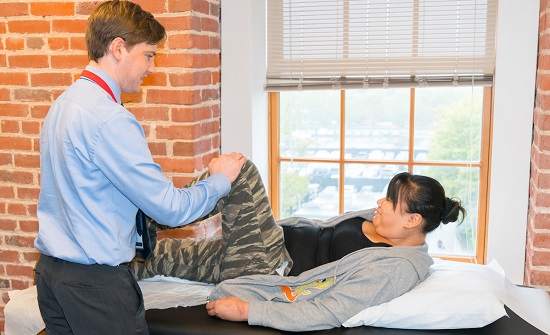ACL Injury

The anterior cruciate ligament (ACL) is one of the main ligaments that stabilize your knee. It is in the center of the knee. The ACL keeps your thighbone and shin bone in line and prevents the knee from giving out with pivoting, twisting, and jumping.
An injury to any ligament is a sprain. Sprains range from microscopic tearing, categorized as Grade 1, to complete tear (Grade 3). Most ACL sprains are high-grade, which means that there is a complete or near complete tear of the ligament.
ACL tears are among the most common knee injuries. People who are 15 to 45 years old have the most ACL injuries because they are usually more active and play more sports. Female athletes have a higher risk of ACL tears than males do. Reasons include pelvic differences, leg alignment and effects of estrogen on ligaments.
Causes of an ACL Tear
ACL injuries usually result from sudden twisting motions such as:
- Stops or changes in direction
- Falls, slips and trips
- Improper landing from a jump
- Contact or collision, such as a football tackle
The most common symptoms of a torn ACL include the knee giving out or buckling when planting your foot. You may feel or hear a pop from your knee followed by pain and swelling. Your knee may feel loose or unstable when you try to stand. It is also very common to injure other ligaments, meniscus, and cartilage at the same time as the ACL tear.
Orthopedic surgeons at University of Maryland Medical Center diagnose ACL injuries during a physical examination. We compare the function of your injured and uninjured knees. Then we use X-ray to find any broken bones and MRI (magnetic resonance imaging) for detailed images of soft tissue.
Nonsurgical ACL Injury Treatment
Unfortunately, most ACL tears won’t heal without surgery. Non-operative treatments offer relief of symptoms, but do not restore stability.
Physical therapy can relieve pain and restore range of motion and strength. A knee brace can stabilize your knee, and crutches help you keep weight off it. Most patients are able to resume daily activity with a torn ACL, but the knee is not stable for rotation or jumping.
The risk after an ACL tear is that more strenuous activities will cause the knee to give out again and will cause more damage to the knee. When the knee gives out again, there is even more shear on the meniscus, which frequently causes additional meniscus tears and cartilage damage.
ACL Surgery
Because the ACL can’t be stitched back together, you need reconstruction surgery to restore knee stability. ACL reconstruction means rebuilding the ligament.
Our orthopedic knee surgeons, who specialize in acute injuries and sports medicine, replace the torn ligament with part of a tendon from your knee or donor tendon tissue. A small camera called an arthroscope lets the surgeon see inside the knee joint during surgery.
ACL Surgery Recovery
Physical therapy is an important part of your recovery. The goal of physical therapy is to reduce pain and swelling, restore range of motion and increase muscle strength. It can take up to one year for your knee to return to normal.
Athletes can expect to return to play once they regain the full range of motion, strength and endurance and there is no more swelling or pain.
Our sports medicine team care for athletes at the high school, collegiate, and professional level. In addition, they work with active patients of all ages to maintain training and get you back to your sport in good condition, as quickly as possible.
Make an Appointment
Make an appointment with one of our orthopedic specialists or learn more about our services, locations and treatment options. Call 410-448-6400.
